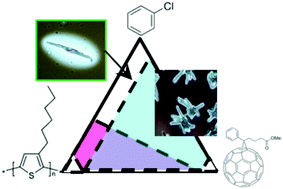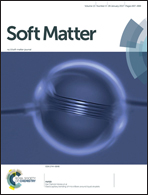Impact of solution phase behaviour and external fields on thin film morphology: PCBM and RRa-P3HT model system†
Abstract
We report the impact of the ternary solution phase behaviour on the film morphology and crystallization of a model polymer:fullerene system. We employ UV-Vis absorption spectroscopy, combined with sequential filtration and dilution, to establish the phase diagram for regio-random poly(3-hexylthiophene-2,5-diyl) and phenyl-C61-butyric acid methyl ester (PCBM) in chlorobenzene. Films are systematically cast from one- and two-phase regions decoupling homogeneous and heterogenous nucleation, and the role of pre-formed aggregates from solutions. Increasing annealing temperature from 120 to 200 °C reveals a highly non-monotonic nucleation profile with a maximum at 170 °C, while the crystal growth rate increases monotonically. UV ozonolysis is employed to vary substrate energy, and found to increase nucleation rate and to promote a binary crystallization process. As previously found, exposure to light, under an inert atmosphere, effectively suppresses homogeneous nucleation; however, it has a considerably smaller effect on heterogeneous nucleation, either from solution aggregates or substrate-driven. Our results establish a quantitative link between solution thermodynamics, crystallization and provide insight into morphological design based on processing parameters in a proxy organic photovoltaic system.


 Please wait while we load your content...
Please wait while we load your content...